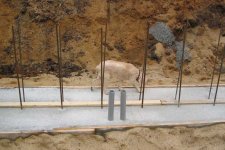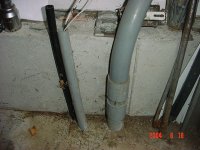Glad to be of help..... I know you couldn't see it in the picture of my garage, but I thought it out well before doing mine. Now if I could only find the floor.... LOL.... One trick that I didn't mention was to put a few holes on the foundation wall above the floor. If you don't use them, you just cement them in later on. This is accomplished by hanging pieces of PVC pipe on nails on the foundation forms walls. The contractor can help you with this. I would put a few on each wall in the event that you want to run something outside without drilling through the wood. An example of this would be air lines. I filled mine with expanding foam and just dug out the foam when I wanted to use one.... You can never have enough places to get through the concrete. For those times that I don't have a hole where I need it, I have a Milwaukee hammer drill...... a big one at that!!!!!
As for coming up the outside of the building, you can do that also, but my preference is always to keep everything inside where possible. There is nothing wrong with coming up the outside and then drilling a hole in the side wall. When you do the outside PVC, there is a sliding PVC joint that accomodates any movement so the PVC will not be under stress and crack. It is called an "expansion joint" and I believe that it is required by code. If the slab is going to be floating, and the question will be how much movement there will be. In that event, it might be the better method going on the outside, because if the slab moves a lot, and the PVC can't, it will crack. This is a variable that you will have to get guidance from the local building officials. As for the water, you can pull line through at a later date, after the final inspection and certificate of occupancy is issued. This provision for water, I would definitely put under the slab for frost protection. If it is deep enough to be safe from frost and inside the building, you will be relatively safe from movement problems. Besides, if there is a crack in the PVC that the water line runs through, it will not harm anything. The local topography and water table needs to be considered at all times to make the decision as to what is best. If the garage is on the top of a knoll or hill, there wouldn't be much standing water in the ground.... if it is low lands, then all bets are off. For the small amount of money involved, I would put it in the floor anyway and then if you change your mind, all that you have wasted is less than $50 worth of materials. If you put the outside PVC pipes in sand, then it will lessen the problems of frost. Most conduit problems are a result of poor installation techniques, not materials.


